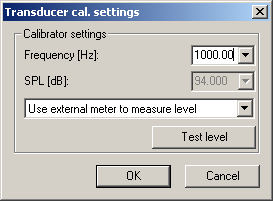
Output transducer sensitivity calibration
Before you start calibrating your computer you must make sure the sound card output sensitivity and amplifier gain and status (checked/unchecked) is correct. Therefore we recommend that you calibrate the sound card sensitivity (see above) before calibrating the transducer sensitivity.

Start the calibration preparation by checking  , and select in the list box the unit of the transducer you are using (for a loudspeaker it would be Pres [Pa]).
, and select in the list box the unit of the transducer you are using (for a loudspeaker it would be Pres [Pa]).

Click on the  button to the right of the Transducer sensitivity to display the settings.
button to the right of the Transducer sensitivity to display the settings.

From this dialog box you can set the level and frequency for the calibration, and choose if you want to use an external signal generator or use the sound card output as signal generator. Using the sound card input for measuring the output level is fine if you have calibrated the input.
If you are to use an external meter to measure the output level, choose Use external meter to measure level in the list box. Then measure the output level on channel 1 (left) in the transducer unit (e.g. SPL) using the external device. Use a SPL meter if you are calibrating a loudspeaker. Measure the level after clicking the  button. Type the measured level in the dialog box below the frequency setting (you are also asked to enter the level during the actual calibration, the level you have typed now will show as default).
button. Type the measured level in the dialog box below the frequency setting (you are also asked to enter the level during the actual calibration, the level you have typed now will show as default).
If are to use the sound card input to measure the level, select Use soundcard input to measure level. The sound card input will now measure and determine the level automatically, no number to be typed, but you must be sure that the sound card input is calibrated properly (considering if you are using amplifier and transducer on the input) and that it is connected to input channel 1 (left).
Now click the  button to perform the calibration. After the calibration is performed, the number to the left and the date to the right of the
button to perform the calibration. After the calibration is performed, the number to the left and the date to the right of the  button will be updated with the new settings. Now you can do a measurement to test if the calibration is correct. You can use sinusoid as excitation signal (see How to use a sinusoidal excitation signal?).
button will be updated with the new settings. Now you can do a measurement to test if the calibration is correct. You can use sinusoid as excitation signal (see How to use a sinusoidal excitation signal?).